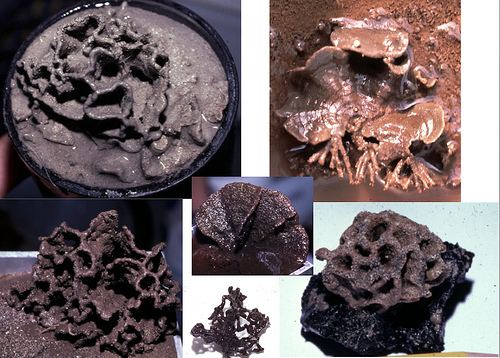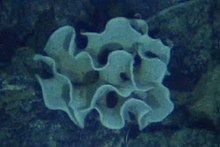Domain Eukaryota Scientific name Xenophyophorea Rank Class | Subphylum Foraminifera Higher classification Forams Phylum Retaria | |
 | ||
Similar Forams, Syringammina fragilissima, Eukaryote, Rotaliida, Allogromiida | ||
Xenophyophore
Xenophyophores are giant multinucleate single celled organisms found on the ocean floor throughout the world's oceans, at depths of 500 to 10,600 meters (1,640 feet to 6.6 miles). They are a kind of foraminifera that extract minerals from their surroundings and use them to form an exoskeleton known as a test.
Contents

They were first described by Henry Bowman Brady in 1883. They are abundant on abyssal plains, and in some regions are the dominant species. Fourteen genera and approximately 60 species have been described, varying widely in size. The largest, Syringammina fragilissima, is among the largest known coenocytes, reaching up to 20 centimetres (7.9 in) in diameter.

Description

Xenophyophores are an important component of the deep sea-floor, as they have been found in all four major ocean basins. However, so far little is known about their biology and ecological role in deep-sea ecosystems.

They form delicate and elaborate agglutinated tests that range from a few millimetres to 20 centimetres. Species of this group are morphologically variable, but the general structural pattern includes a test enclosing a branching system of organic tubules together with masses of waste material (stercomata). The softness and structure of tests varies from soft and lumpy shapes to fans and complex structures.
Xenophyophores are often found in areas of enhanced organic carbon flux, such as beneath productive surface waters, in sub-marine canyons, in settings with sloped topography (e.g. seamounts, abyssal hills) and on continental slopes. They select certain minerals and elements from their environment that are included in its tests and cytoplasm, or concentrated in excretions. The selected minerals vary with species, but often include barite, lead and uranium.
Naming and classification
Their name Xenophyophora means "bearer of foreign bodies", from the Greek. This refers to the sediments, called xenophyae, which are cemented together to construct their tests. In 1883, Henry Bowman Brady classified them as primitive Foraminifera. Later they were placed within the sponges. In the beginning of the 20th century they were considered an independent class of Rhizopoda, and later as a new eukaryotic phylum of Protista. As of 2015, recent phylogenetic studies suggest that xenophyophores are a specialized group of monothalamous (single-chambered) Foraminifera.
Feeding
As benthic detritivores, xenophyophores root through the muddy sediments on the sea floor. They excrete a slimy substance while feeding; in locations with a dense population of xenophyophores, such as at the bottoms of oceanic trenches, this slime may cover large areas. These giant protozoans seem to feed in a manner similar to amoebas, enveloping food items with a foot-like structure called a pseudopodium. Most are epifaunal (living atop the seabed), but one species (Occultammina profunda), is known to be infaunal; it buries itself up to 6 centimetres (2.4 in) deep into the sediment.
Ecology
Local population densities may be as high as 2,000 individuals per 100 square metres (1,100 sq ft), making them dominant organisms in some areas. Xenophyophores may be an important part of the benthic ecosystem due to their bioturbation of sediment, providing a habitat for other organisms such as isopods. Research has shown that areas dominated by xenophyophores have 3–4 times the number of benthic crustaceans, echinoderms, and molluscs than equivalent areas that lack xenophyophores. The xenophyophores themselves also play commensal host to a number of organisms—such as isopods (e.g., genus Hebefustis), sipunculan and polychaete worms, nematodes, and harpacticoid copepods—some of which may take up semi-permanent residence within a xenophyophore's test. Brittle stars (Ophiuroidea) also appear to have a relationship with xenophyophores, as they are consistently found directly underneath or on top of the protozoans.
Xenophyophores are difficult to study due to their extreme fragility. Specimens are invariably damaged during sampling, rendering them useless for captive study or cell culture. For this reason, very little is known of their life history. As they occur in all the world's oceans and in great numbers, xenophyophores could be indispensable agents in the process of sediment deposition and in maintaining biological diversity in benthic ecosystems.
